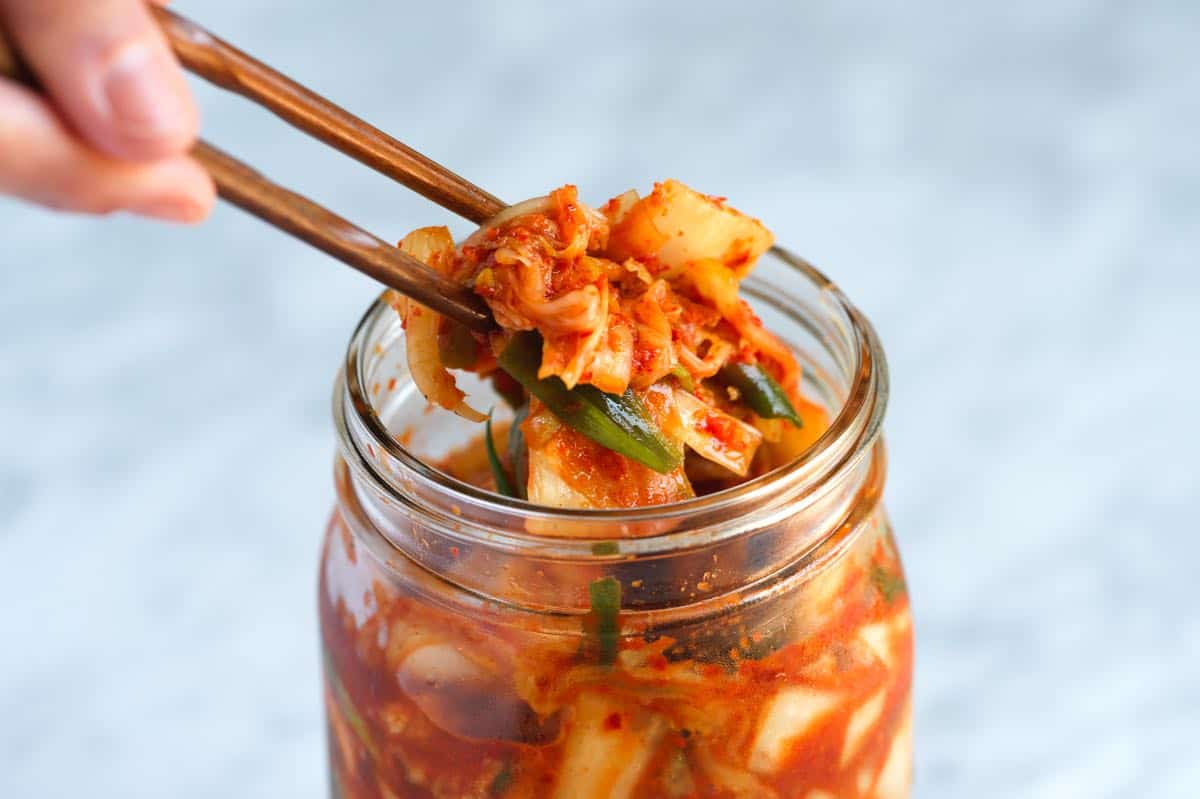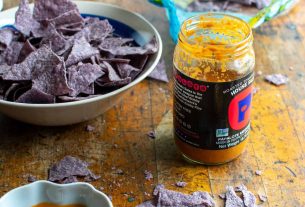Imagine a dish that awakens your taste buds, igniting a symphony of flavors on your tongue.
Picture a tangy, spicy, and slightly sour concoction that transports you to the vibrant streets of Korea.
Curious to know what this magical dish is?
Look no further than kimchi – a Korean culinary masterpiece that will leave you craving for more.
But wait, what does kimchi taste like?
Let’s dive into its delightful flavors and uncover the secrets of this beloved dish.
what does kimchi taste like
Kimchi has a tangy and spicy flavor profile that can pack quite a punch in terms of heat.
The balance between spicy heat and sourness makes for an addictive combination.
It has a distinct flavor due to its combination of spices and fermented ingredients.
Kimchi is known for its umami and salty undertones.
The fermentation process gives kimchi a slightly sour taste that complements its spiciness.
Additionally, kimchi has a crunchy texture that sets it apart from other condiments.
Key Points:
- Tangy and spicy flavor with a punch of heat
- Addictive combination of spicy heat and sourness
- Distinct flavor from spices and fermentation
- Umami and salty undertones
- Slightly sour taste that complements its spiciness
- Crunchy texture, setting it apart from other condiments
what does kimchi taste like – Watch Video
💡
Pro Tips:
1. Kimchi is often referred to as Korean sauerkraut, but its taste is far more complex than that of its German counterpart. It has a unique combination of spicy, sour, and umami flavors, making it a truly distinct culinary experience.
2. Did you know that there are over 200 different varieties of kimchi? While the most common type is made with napa cabbage, other versions include radish kimchi, cucumber kimchi, and even water kimchi.
3. Historically, kimchi was not always a spicy dish. The use of chili peppers, which give it its signature heat, only became widespread in Korea during the 18th century.
4. When kimchi is fermented, it undergoes a process called lactic acid fermentation, similar to the one used to make yogurt and pickles. This fermentation not only gives it tangy flavor but also increases its nutritional value, making it rich in vitamins, fiber, and probiotics.
5. During the Korean War, kimchi was such an essential part of the diet that the South Korean government even set up a committee to ensure that soldiers in the army were provided with it regularly. Today, it is considered a staple in Korean cuisine and is served at almost every meal.
Introduction: What Is Kimchi And How Is It Made?
Kimchi, a traditional Korean dish, is a beloved staple in Korean cuisine. It is made by fermenting cabbage or other vegetables with seasonings and spices. The most common type of kimchi is made with Napa cabbage, also known as baechu in Korean. However, there are also variations such as radish kimchi (kkakdugi) or cucumber kimchi (oi sobagi). Kimchi-making is a cherished cultural practice that has been passed down through generations in Korea.
To make kimchi, the cabbage is first cut into pieces and then soaked in a brine solution of saltwater. This helps to soften the cabbage and remove excess moisture. Once the cabbage is ready, it is then seasoned with a mixture of spices and ingredients such as garlic, ginger, chili peppers, fish sauce, or salted shrimp paste. The seasoned cabbage is then left to ferment for a certain period, during which the flavors develop and intensify.
Types Of Kimchi: Napa Cabbage, Radish, And Cucumber Kimchi
Napa cabbage kimchi, or baechu kimchi, is the most widely recognized type of kimchi. It is made by fermenting Napa cabbage leaves with a flavorful blend of spices. This type of kimchi is known for its robust flavors and crunchy texture.
Radish kimchi, or kkakdugi, is made by fermenting cubed radishes seasoned with similar ingredients as cabbage kimchi. It offers a refreshing and slightly tangy taste.
Cucumber kimchi, or oi sobagi, is made by soaking cucumbers in a mixture of saltwater, garlic, ginger, and chili flakes. This variation of kimchi is tangy, refreshing, and provides an added crunch.
The Taste Of Kimchi: Varies With Recipe And Fermentation Time
The taste of kimchi can vary depending on the recipe and fermentation time. Generally, the longer kimchi ferments, the stronger and more sour the flavor becomes. The balance between spicy heat and sourness makes for an addictive combination. The fermentation process gives kimchi a slightly sour taste that complements its spiciness. Some kimchis are milder in spice, while others are fiery hot. The variety in taste allows individuals to find a kimchi that suits their preference.
- The taste of kimchi can vary depending on the recipe and fermentation time.
- Generally, the longer kimchi ferments, the stronger and more sour the flavor becomes.
- The balance between spicy heat and sourness makes for an addictive combination.
- The fermentation process gives kimchi a slightly sour taste that complements its spiciness.
- Some kimchis are milder in spice, while others are fiery hot.
- The variety in taste allows individuals to find a kimchi that suits their preference.
Tangy And Spicy: Kimchi’s Punchy Flavor Profile
Kimchi is a fermented Korean dish known for its tangy and spicy flavor profile. It has a distinct taste thanks to a combination of spices and fermented ingredients. Garlic, ginger, and chili peppers are the main components that contribute to its bold flavor. The tanginess of kimchi is a result of the fermentation process, which also balances out the spiciness.
In summary, kimchi offers a unique and exciting culinary experience with its blend of distinct flavors.
–Tangy and spicy flavor profile
–Distinct taste due to combination of spices and fermented ingredients
–Garlic, ginger, and chili peppers contribute to bold flavor
–Tanginess from fermentation process balances spiciness
Main Ingredients: Cabbage, Garlic, Ginger, Chili Peppers, Fish Sauce Or Shrimp Paste
The main ingredients of kimchi are cabbage, garlic, ginger, chili peppers, fish sauce, or salted shrimp paste. Napa cabbage is the base ingredient, providing a crisp and hearty foundation. Garlic and ginger add aromatic and savory notes, enhancing the overall flavor. Chili peppers give kimchi its signature spiciness. Fish sauce or salted shrimp paste contributes to the umami taste, adding depth and complexity to the dish. These ingredients work harmoniously to create the distinctive taste of kimchi.
Fermentation Process: Adding Sourness To Kimchi
The fermentation process is crucial in making kimchi. It is during this process that the flavors of kimchi develop and transform. Fermentation gives kimchi its slightly sour taste, which complements its spiciness. During fermentation, beneficial bacteria convert sugars in the cabbage and other ingredients into lactic acid, creating that characteristic tang. The length of fermentation can vary, with some kimchi fermenting for days and others for weeks. This process contributes to the overall taste and texture of kimchi.
Spice Level: Mild To Fiery Hot Kimchi
Kimchi’s spice level can vary, catering to different heat preferences. Some kimchi varieties are mild in spice, allowing individuals who are less tolerant of heat to enjoy it. On the other hand, there are kimchi types that are fiery hot, perfect for those who enjoy a spicy kick. The amount of chili pepper flakes used during the seasoning process determines the spiciness level of the kimchi. Whether you prefer a milder or spicier kimchi, there is a variation to suit your palate.
- Kimchi’s spice level can range from mild to fiery hot.
- Mild kimchi varieties are suitable for those who prefer less spice.
- Fiery hot kimchi is perfect for individuals who enjoy a spicy kick.
“The spiciness level of kimchi is determined by the amount of chili pepper flakes used during the seasoning process.”
Distinct Flavor: Combination Of Spices And Fermented Ingredients
Kimchi stands out among other condiments due to its distinct flavor. The combination of spices and fermented ingredients contributes to its unique taste. The garlic and ginger bring savory and aromatic elements, while the chili peppers provide a fiery kick. The fermentation process lends kimchi its tanginess, creating a multifaceted flavor profile. The umami taste from fish sauce or salted shrimp paste adds depth and richness, completing the overall taste experience.
Crunch Factor: Kimchi’s Unique Texture
One of the characteristics that sets kimchi apart is its crunch factor. Whether it’s made with Napa cabbage, radish, or cucumber, kimchi offers a delightful crunch that adds to the overall eating experience. The cabbage leaves retain their crispness, providing a satisfying texture. This crunchiness balances the bold flavors of kimchi, creating a harmonious mouthfeel.
Variations: White Kimchi And Cucumber Kimchi
Kimchi, a beloved Korean dish, comes in various forms, each with its own distinct taste. One of these variations is white kimchi, also known as baek-kimchi. Unlike traditional kimchi, white kimchi is milder and made with Napa cabbage, garlic, ginger, and sometimes pear for sweetness. It offers a tangy and slightly sweet taste.
Another delightful option is cucumber kimchi, also known as oi sobagi. This variation involves soaking cucumbers in a mixture of saltwater, garlic, ginger, and chili flakes. The result is a tangy and refreshing flavor, perfect for those who prefer a lighter taste. To add variety and crunch, cucumber kimchi can also include other vegetables like radishes or carrots.
In addition, kimchi as a whole is a versatile and flavorful dish with a tangy and spicy taste profile. Its distinct flavors are achieved through the combination of various spices and fermented ingredients. The classic Napa cabbage kimchi, the refreshing cucumber kimchi, and the milder white kimchi offer a wide range of options for all taste preferences.
The fermentation process of kimchi adds a slightly sour taste that perfectly complements the spice, making it a truly addictive and unique culinary experience.
So, if you haven’t tried kimchi yet, I highly recommend giving it a go and exploring the bold, tangy flavors that this beloved Korean dish has to offer.
- Kimchi comes in various forms with distinct tastes.
- White kimchi is made with Napa cabbage, garlic, ginger, and sometimes pear for sweetness, and has a tangy and slightly sweet taste.
- Cucumber kimchi offers a tangy and refreshing flavor, perfect for those who prefer a lighter taste. It can include other vegetables like radishes or carrots.
- Kimchi is versatile and flavorful, with a tangy and spicy taste profile.
- The fermentation process adds a slightly sour taste that complements the spice, making kimchi a truly unique culinary experience.
💡
You may need to know these questions about what does kimchi taste like
How do you eat kimchi for the first time?
If you want to experience the traditional way of eating kimchi, try having it as a side dish with a Korean meal. Start by taking a small portion of rice and wrapping it with a piece of kimchi using chopsticks. The combination of the tangy and spicy flavors of kimchi with the neutral taste of rice creates a delicious harmony that is enjoyed by many Koreans. By immersing yourself in the authentic culture and cuisine, your first bite of kimchi will be a memorable and immersive experience.
Is kimchi an acquired taste?
Indeed, kimchi is often considered an acquired taste due to its distinctive flavor profile and fermentation process. Like bleu cheese, vegemite, or anchovies, kimchi has a strong and pungent taste that may not immediately appeal to everyone’s palate. The combination of fermented cabbage, chili peppers, garlic, and other ingredients creates a unique and sometimes spicy taste that might take some time for individuals to appreciate and enjoy. However, those who appreciate the complexity and tanginess of kimchi often develop a fondness for it over time, finding its bold flavors to be a delightful addition to various dishes or even by itself.
Does kimchi taste like sauerkraut?
While both sauerkraut and kimchi are fermented cabbage dishes, their taste profiles differ significantly. Sauerkraut has a tangy and acidic flavor, providing a refreshing zest to the palate. On the other hand, kimchi offers a salty and potentially spicy taste, often referred to as umami, which adds a savory depth. The diversity in kimchi’s flavor stems from the various vegetables incorporated in its preparation, whereas sauerkraut consistently delivers the distinct fermented cabbage essence. Thus, while they share a common ingredient, sauerkraut and kimchi possess individual tastes that are uniquely their own.
Is kimchi eaten warm or cold?
Kimchi is traditionally enjoyed both warm and cold, offering different culinary experiences. If you prefer to savor the live cultures and nutritional benefits it provides, it is best to consume kimchi cold. Cold kimchi dishes such as cold noodles with kimchi offer a refreshing and delightful way to incorporate this fermented delicacy into your meals.
Reference source
https://culturesforhealth.com/blogs/learn/what-is-kimchi-what-does-kimchi-taste-like
https://www.epicurious.com/expert-advice/how-to-eat-kimchi-korean-pickle-in-soup-stews-noodles-article
https://fermentaholics.com/what-is-kimchi-and-why-you-should-eat-it/
https://www.masterclass.com/articles/sauerkraut-vs-kimchi-explained



